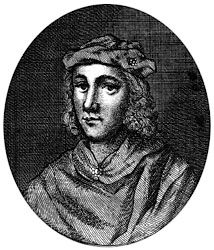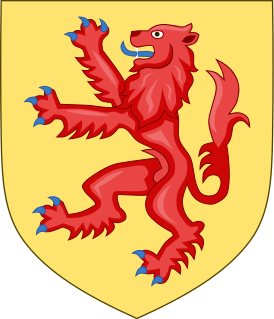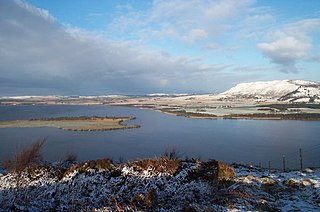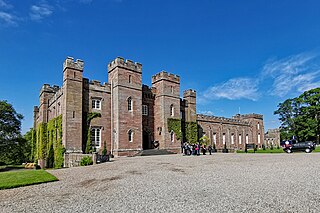
Alexander I, posthumously nicknamed The Fierce, was the King of Scotland from 1107 to his death. He succeeded his brother, King Edgar, and his successor was his brother David. He was married to Sybilla of Normandy, an illegitimate daughter of Henry I of England.

Constantine, son of Áed was an early King of Scotland, known then by the Gaelic name Alba. The Kingdom of Alba, a name which first appears in Constantine's lifetime, was situated in modern-day Scotland.

Malcolm IV, nicknamed Virgo, "the Maiden" was King of Scotland from 1153 until his death. He was the eldest son of Henry, Earl of Huntingdon and Northumbria and Ada de Warenne. The original Malcolm Canmore, a name now associated with his great-grandfather Malcolm III, he succeeded his grandfather David I, and shared David's Anglo-Norman tastes.
Cináed mac Duib, anglicised as Kenneth III, and nicknamed An Donn, "the Chief" or "the Brown", was King of Scots from 997 to 1005. He was the son of Dub. Many of the Scots sources refer to him as Giric son of Kenneth son of Dub, which is taken to be an error. An alternate explanation is that Kenneth had a son, Giric, who ruled jointly with his father.
In early medieval Scotland, a mormaer was the Gaelic name for a regional or provincial ruler, theoretically second only to the King of Scots, and the senior of a Toísech (chieftain). Mormaers were equivalent to English earls or Continental counts, and the term is often translated into English as 'earl'.
The Earl of Fife or Mormaer of Fife was the ruler of the province of Fife in medieval Scotland, which encompassed the modern counties of Fife and Kinross. Due to their royal ancestry, the earls of Fife were the highest ranking nobles in the realm, and had the right to crown the king of Scots.
Causantín or Constantine of Fife is the first man known for certain to have been Mormaer of Fife.
Donnchad II, anglicized as Duncan II or Dunecan II, succeeded his father Duncan I as Earl of Fife in childhood. As a child of the previous mormaer, he was entitled to succeed his father through primogeniture, but not to lead his kin-group, Clann MacDuib. That probably fell to his cousin, Aed mac Gille Míchéil. Like previous mormaers of Fife, Duncan II was appointed Justiciar of Scotia. Donnchad's minority also meant that Ferchar, Mormaer of Strathearn, took supreme place as head of the Gaelic nobility and guide for the boy-king Malcolm IV.

Máel Coluim II, was a 13th-century Mormaer of Fife who ruled the mormaerdom or earldom of Fife between 1228 and 1266. He was the nephew of Máel Coluim I, the previous mormaer, and the son of Máel Coluim I's brother Donnchadh, son of Donnchadh II.

Donnchadh IV, Earl of Fife [Duncan IV] (1289–1353) was sometime Guardian of Scotland, and ruled Fife until his death. He was the last of the native Scottish rulers of that province.

Fearchar of Ross or Ferchar mac in tSagairt, was the first of the Scottish Ó Beólláin family who received by Royal Grant the lands and Title of Mormaer or Earl of Ross (1223–1251) we know of from the thirteenth century, whose career brought Ross into the fold of the Scottish kings for the first time, and who is remembered as the founder of the Earldom of Ross.
Moray was a province within the area of modern-day Scotland, that may at times up to the 12th century have operated as an independent kingdom or as a power base for competing claimants to the Kingdom of Alba. It covered a different and much larger territory than the modern council area of Moray, extending approximately from the River Spey in the east to the River Beauly in the north, and encompassing Badenoch, Lochaber and Glenelg in the south and west.
Ethelred was the son of King Malcolm III of Scotland and his wife Margaret of Wessex, the third oldest of the latter and the probable sixth oldest of the former. He took his name, almost certainly, from Margaret's great-grandfather Æthelred the Unready. He became the lay abbot of Dunkeld.
Scottish Society in the High Middle Ages pertains to Scottish society roughly between 900 and 1286, a period roughly corresponding to the general historical era known as the High Middle Ages.
The Meic Uilleim (MacWilliams) were the Gaelic descendants of William fitz Duncan, grandson of Máel Coluim mac Donnchada, king of Scots. They were excluded from the succession by the descendants of Máel Coluim's son David I during the 12th century and raised a number of rebellions to vindicate their claims to the Mormaerdom of Moray and perhaps to the rule of Scotland.
The MacHeths were a Celtic kindred who raised several rebellions against the kings of Scotland in the 12th and 13th centuries. Their origins have long been debated.

St Serf's Inch or St Serf's Island is an island in Loch Leven, in south-eastern Perth and Kinross, Scotland. It was the home of a Culdee and then an Augustinian monastic community, St Serf's Inch Priory.

Political and military events in Scotland during the reign of David I are the events which took place in Scotland during David I of Scotland's reign as King of Scots, from 1124 to 1153. When his brother Alexander I of Scotland died in 1124, David chose, with the backing of Henry I of England, to take the Kingdom of Alba for himself. David was forced to engage in warfare against his rival and nephew, Máel Coluim mac Alaxandair. Subduing the latter took David ten years, and involved the destruction of Óengus, mormaer of Moray. David's victory allowed him to expand his control over more distant regions theoretically part of the Kingdom. In this he was largely successful, although he failed to bring the Earldom of Orkney into his kingdom.

Scone is a town in Perth and Kinross, Scotland. The medieval town of Scone, which grew up around the monastery and royal residence, was abandoned in the early 19th century when the residents were removed and a new palace was built on the site by the Earl of Mansfield. Hence the modern village of Scone, and the medieval village of Old Scone, can often be distinguished.
Thane was the title given to a local royal official in medieval eastern Scotland, equivalent in rank to the son of an earl, who was at the head of an administrative and socio-economic unit known as a thanedom.